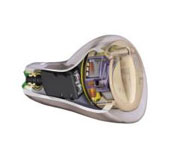
You do have hearing loss
Then it helps to know that you’re not alone. In fact, you are one of about 500 million people worldwide. In most countries, this means more than 1 in 6 people have some degree of hearing loss. But it’s reassuring to know that a properly fitted hearing instrument can improve communication in at least 90% of people with hearing loss. This means you can be quite confident that there is a solution.
Pure Audiology & Hearing Aid Services offers hearing solutions to enhance nearly every listening situation imaginable. The right choice of hearing instrument type and technology is determined by the individual hearing loss and patients specific needs. The following explanations may be useful to you.
The basics of a hearing instrument hearing aid instrument
 Every hearing instrument has one or more microphones which pick up sound from the environment. This acoustic signal is transformed to an electrical signal; it is amplified and adapted according to the individual hearing loss. The receiver (or “loudspeaker”) then reconverts it to an acoustic signal which is directed down the ear canal.
Every hearing instrument has one or more microphones which pick up sound from the environment. This acoustic signal is transformed to an electrical signal; it is amplified and adapted according to the individual hearing loss. The receiver (or “loudspeaker”) then reconverts it to an acoustic signal which is directed down the ear canal.
Digital Technology
Thanks to increasingly small micro-processors, digital technology has been applied to hearing systems. Digital hearing instruments are programmed by a hearing care professional via a PC. Within the hearing instruments, acoustic signals are transformed at high speed and with great precision into a binary code. This allows much more complex calculations and adjustment of the amplified signal than is possible with analog technology. It gives greater flexibility in providing individualized solutions to hearing loss, and allows the addition of features which give the instruments higher value across a greater number of listening situations.
Digital Technology
Noise, reverberation, and distance: Whenever even latest-generation hearing instruments approach the limits of their capabilities, FM technology, combined with hearing instruments, significantly enhances the ability of hearing-impaired people to communicate in the most difficult listening situations. Barriers to clear hearing can be successfully overcome because speech and sound are transmitted directly to the hearing-impaired person’s ears, without interfering noise.
Bone Amplification Hearing Device (BAHD)
The BAHD is a surgically implantable system for treatment of hearing loss that works through direct bone conduction. BAHD is used to help people with chronic ear infections, congenital external auditory canal atresia and single sided deafness who cannot benefit from conventional hearing aids. Since 1977, BAHD has offered an alternative solution for certain groups of patients and today, more than 7,000 patients have been treated with BAHD. The system is surgically implanted and allows sound to be conducted through the bone rather than via the middle ear – a process known as direct bone conduction. The surgery is normally carried out in two stages and can be done under either local or general anaesthetic. Both operations are minor and take approximately one hour.
Cochlear Implant
A cochlear implant is an electronic device which is surgically implanted in the inner ear of a person who is profoundly or completely deaf. Unlike hearing aids, the implant does not make sounds louder or clearer. Instead, it stimulates the hearing nerve directly. A cochlear implant will give the hearing-impaired person a sensation of hearing. It is important to understand that it only provides a reduced sense of hearing, not a fully restored hearing sense. Therefore, it takes time, practice and patience to learn how to use a cochlear implant. There are cochlear implant centres of expertise in both Toronto and London. If you are deemed a candidate for a cochlear implant we would discuss this with your family physician and refer you to one of these two centres.

